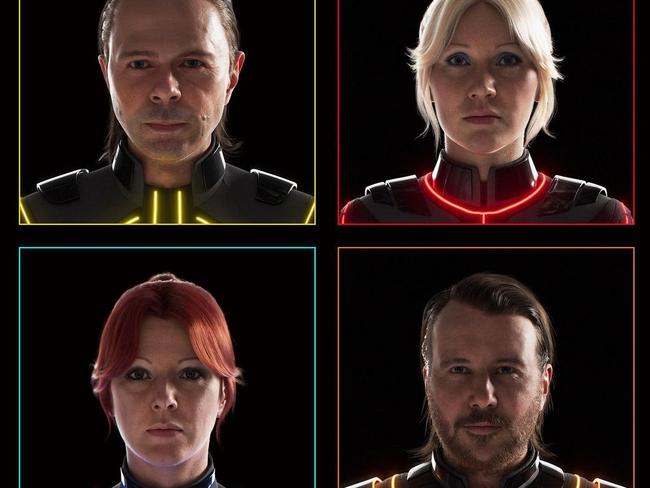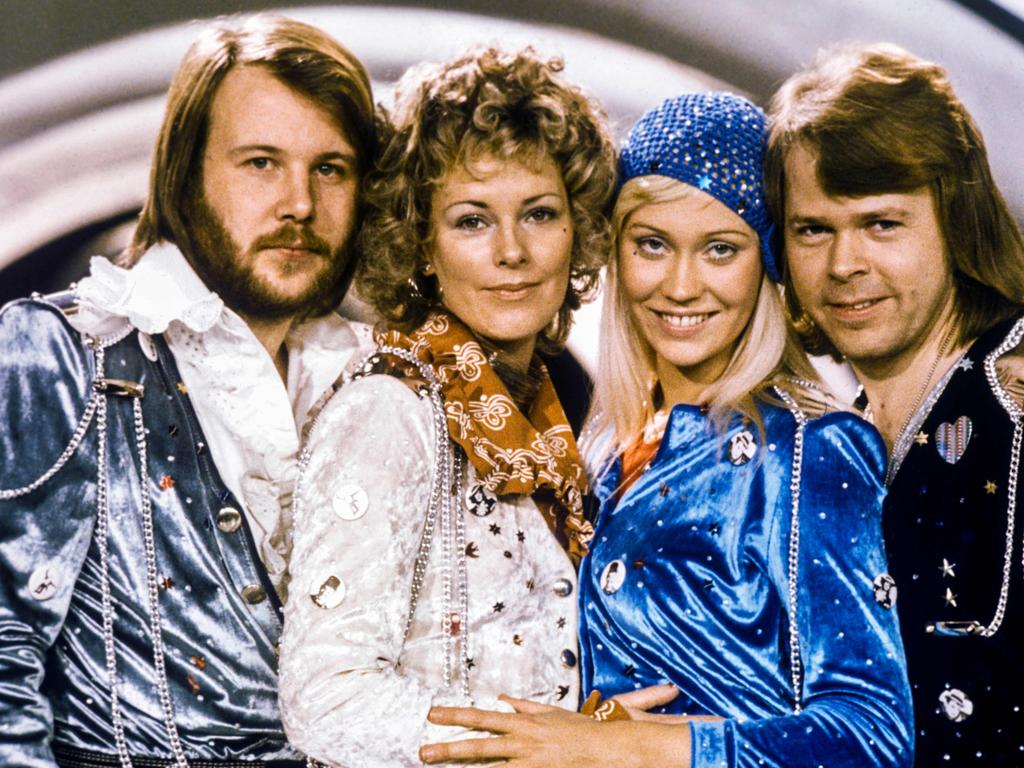My My! The inside story of how ABBA got back together
Forty years after their last album, ABBA are back with new songs and a show. Bjorn Ulvaeus reveals how it all happened.

Dust off the sequins, launder the catsuits, polish the platform boots. Forty years after they last gave us their blend of heavenly melodies and emotionally lacerating lyrics, ABBA are back, with new songs, a new album and a string of “digital avatar” shows in London.
The Swedish quartet – Agnetha Faltskog, 71, Bjorn Ulvaeus, 76, Benny Andersson, 74, and Anni-Frid Lyngstad, 75 – have sold 385 million records, had eight consecutive No 1 albums in the UK between 1973 and 1981 and are together worth an estimated $US1 billion.
That sum looks set to skyrocket, although this is obviously all about the music. Two new songs, the stirring I Still Have Faith in You and Don’t Shut Me Down, were released last night (Thursday). On November 5 comes ABBA Voyage, their first new album since The Visitors in 1981.
“Being together in the studio again, it was so familiar. It all came rushing back in seconds,” Ulvaeus, the most media-friendly of the four, told me in April. Did they crack the same jokes? “Not necessarily the same jokes, but, yes, jokes. We had fun. You have to have fun.” Faltskog and Lyngstad sing at a slightly lower pitch these days, he said. “I think their voices are about one tone lower, perhaps. It still sounds very much ABBA.”

The new tracks feature lyrics by Ulvaeus and music by Andersson. “During the ABBA years we worked together with the music and then I would write the words afterwards,” Ulvaeus told me. “But Benny was always the musical genius and I was the word man, so it’s a natural development.”
Then come the ABBA Voyage shows, at a purpose-built, 3000-capacity arena in the Queen Elizabeth Olympic Park, east London, where digital representations of the foursome will mime to the original recordings of Super Trouper, The Winner Takes It All and the rest alongside a ten-piece live band. While Ulvaeus and co kick back at home, their doppelgangers will appear in various virtual guises, from their satin-clad 1970s pomp to futuristic Tron-style space suits.
The concerts have been delayed, partly because of the pandemic and partly to perfect the technology of the “Abbatars”.
They aren’t holograms, apparently, but electronic versions, although it’s unclear what the difference is. Perhaps they are just keen to distinguish themselves from the spate of revival tours featuring holographic Elvis Presleys, Whitney Houstons, Frank Sinatras et al.
ABBA are still alive, which makes their project less ghoulish, if still weird. As seen in the video for I Still Have Faith in You, the de-aged avatars are rather creepy and cyborg-like. It’s the closest we will get to seeing them live, though. “None of us is keen to go on tour, and we never were really,” Ulvaeus said. “Out of a ten-year career we may have toured six months.”

The avatars were designed by an 850-strong team at Industrial Light & Magic, the California whizzes who did the effects on the Star Wars films; this is its first foray into music. ILM persuaded the band to wear motion-capture suits, which will inform the movements of their avatars.
The shows will be choreographed by Wayne McGregor of the Royal Ballet and directed by the film-maker Baillie Walsh (he has worked with Oasis, Kylie Minogue, Kate Moss, Alexander McQueen), and the producers will include Svana Gisla, who has worked with Beyonce and Coldplay and on David Bowie’s Lazarus, and Ludvig Andersson, the son of Benny (Mamma Mia: Here We Go Again!). “It’s another story on another level,” Ulvaeus said in April. Will it be weird to see a virtual version of his young self? “I’m sure.”
Whispers of a reunion had been circulating since 2016, when Faltskog and Lyngstad sang the ABBA song The Way Old Friends Do at a party in Stockholm to celebrate the 50th anniversary of Ulvaeus and Andersson’s first meeting. That same year Simon Fuller, the British impresario behind the Spice Girls and the Pop Idol franchise, announced that he was working on a new project with ABBA. Fuller is not involved with their forthcoming album or shows, which may come as a relief to some.

This reunion, of course, has more reason to be fraught than most. Ulvaeus and Faltskog were married for nine years, divorcing in 1980, while Andersson and Lyngstad were together from 1971 to 1980 and married for two years.
Yet Ulvaeus’s divorce from Faltskog was amicable, he told me: there was no loser standing small. His ex has a reputation as a recluse, but not with him, partly because they have two children together. “We are really, really good friends and we see each other quite often, actually, on birthdays and Christmas and stuff like that,” he said.
Faltskog has released several solo albums since ABBA split, mostly recently A in 2013, which this newspaper called “a triumphant return to form by a woman presumed lost to music forever”. Lyngstad has also had a modest solo career, releasing three albums in Swedish and two in English. In 1992 she married Prince Heinrich of Reuss in Germany and since his death in 1999 she has been the dowager countess of Plauen.
ABBA may not have been together musically or romantically since the 1980s, but, says Mark Sutherland, a music writer and former editor of Music Week, “they’ve certainly been taking care of business. Via a few strategic moves they managed to become even bigger than when they were together. They’ve done that by presenting the music in lots of different ways.”
Ulvaeus and Andersson have contributed to Mamma Mia! the stage musical, the two hit films and Mamma Mia! The Party, the interactive hen-do magnet that returns to the O2 arena in London in October. Then there’s the ABBA museum in Stockholm. “The gift shop alone must make them thousands of Swedish krona every day,” Sutherland says.

Part of ABBA’s commercial renaissance has been down to the critical reassessment that they underwent in the 1980s and 1990s. Before that many had seen them as the incarnation of naff, but that started to change when Elvis Costello covered Knowing Me, Knowing You, Erasure released their ABBA-esque EP in 1992 and Noel Gallagher professed his unapologetic love for SOS and Waterloo. “It removed any residual embarrassment about liking ABBA,” Sutherland says. “If you think that they coexisted with punk rock and they were very much the opposite end of the spectrum. But now there’s no doubt about which of the two is more popular.” The group have been canny about pitching themselves to younger audiences. “They’ve been very conscious of trends in music,” says Sutherland. Ulvaeus has campaigned for streaming services to pay more to songwriters, and ABBA recently joined TikTok, the social media platform popular with under-18s.
“There’s no real need for ABBA to be on TikTok because their music is all over it anyway, but it’s about making sure people connect their music with ABBA the brand, and that will feed back into other areas of the empire,” Sutherland says. “It’s the sort of thing that multimillionaire pop stars often can’t be bothered to do. There’s very few acts that still maintain a much younger audience – Queen, the Beatles, ABBA, and that’s about it, really.”
Sutherland doesn’t think that the new album is important on that front. “I very much doubt it will sell as many copies as ABBA albums have in the past,” he says. After all, the ABBA Gold compilation is the second highest-selling album to date in the UK, having shifted almost six million units.
“But that’s not really an issue because the real money these days is in catalogues being streamed,” adds Sutherland. “Their increased presence in the market is going to cause a big spike in streams of ABBA classics. They have about 17 million monthly listeners on Spotify, which is very good for a band of their vintage. But you’d expect that to go a lot higher.”
So thank you for the music, guys. And in return, here’s our money, money, money.
THE TIMES







To join the conversation, please log in. Don't have an account? Register
Join the conversation, you are commenting as Logout